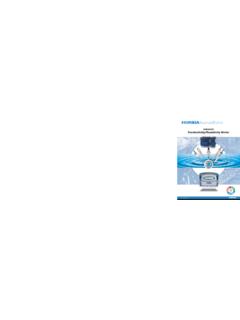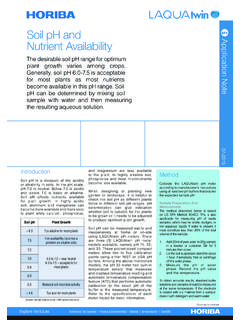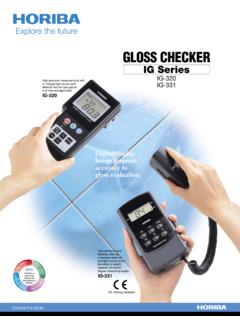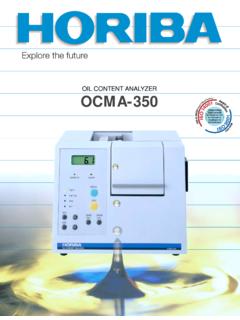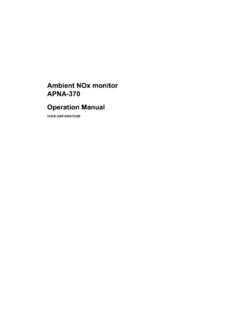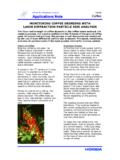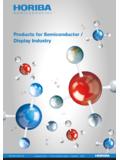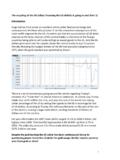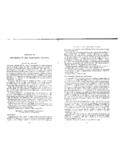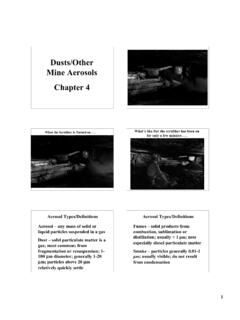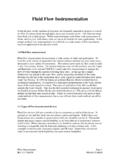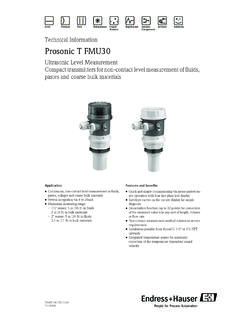Transcription of Zeta Potential of CMP Slurries df FINAL.ppt - HORIBA
1 David Fairhurst, Consultants, LtdThe Utility of Zeta Potential Measurements in the Characterization of CMP SlurriesHORIBA ScientificWebinarJune 12th2013 Dispersed SystemsExtent of InterfaceInterfacial ChemistryStability and StructureSystem PropertiesAn interfacealways exists when one component (phase I) isdispersed in a state of subdivision in a medium (phase II) The interfacial extent and interfacial chemistry are not independent parametersTwo fundamentalparameters control the nature and behavior all dispersed systemsMeasurement Techniques used to Characterize Particulate SuspensionsINTERFACIAL EXTENTINTERFACIAL CHEMISTRYP article Size and Distribution*Particle Shape and Morphology*Surface Area*(external/internal)PorositySurface Charge*Nature/type of group(s)Number and distributionDissociation/ionizationPrefe rential adsorptionHydrophobic/hydrophilic balanceSurface(interfacial)
2 TensionContact Angle*The Nature of Surface Charge in WaterMineral oxide crystal lattices are anisotropic charge development because of nand pdefects in crystal structure results in hydroxyl groups (-OH) can undergo reaction with either H+ or OH- difficult to control surface chemistry in manufacture and processing reactant impuritiesMetal Oxide Surfaces in WaterAdsorption of protons and hydroxyl ionsH+OH-MOH2+ MOH MO-+ H2 OFormation of hydroxylated speciesMn+ + xOH- M(OH)x(n-x)+M(OH)x(n-x)+ + OH- M(OH)x+1(n-x-1)+M(OH)x+1(n-x-1)++ H+ M(OH)x-1(n-x+1)+Dissociation driven by pH avoid swings in pHEquilibria driven by particle concentration constant %solids Nanoparticle Surface Chemistry10nm particle size:ca 30% of molecules/atoms that comprise the molecular structure become surface moieties 1nm particle size:80% of the atoms are on the surfaceA typical micellar solution containing amphiphile has ~4x104 m2of micellar-water interfacial area per liter of solution!
3 For nano-size systems surface charge effects play a dominant role in determining the physicochemical properties (surface chemical activity) of the system as a wholeThe Electric Double Layer = dexp[- x] is termed the Debye-H ckel value is dependent upon the concentration and valence of electrolytic species in solution 0 -cannot be measured d -mathematical concept - experimental parameter d = exp[- x]The electric Potential depends (through ) on the ionic composition of the is increased ( the electric double layer is compressed ) then the Potential must decreaseZeta Potential of Corundum (Al2O3) in Solution of Various ElectrolytesDepends upon: Fundamental surface sites how many, what type Solution conditions temperature, pH, electrolyte concentrationUseless to quote a zeta Potential value without specifying suspension conditionsZeta Potential : The Effective Surface Charge in solutionMost common measurement technique: microelectrophoresis (ELS/PALS)Electrophoretic mobility, UE= Vp/ExVp is the particle velocity ( m/s) and Exis the applied electric field (Volt/cm) Relation between and UE is non-linear.
4 UE =2 0 F( a)/3 The Henry coefficient, F( a), is a complex function of Calculation of the zeta Potential is not determined directlyAll modern commercial instruments provide both the measured electrophoretic mobility and an estimation of the zeta potentialThe Effect of pH on Zeta Potential ISOELECTRIC pHAcidicSurfaceBasicSurfaceMaximum dissociation/ionizationof surface groupsMaximum dissociation/ionization of surface groupsImperative to determine ZP vs pH profile for any CMP agent prior to useZeta potentialpHpositivenegative71400 Aqueous Isoelectric Points of Silica and Alumina pHZeta Potential (mV)Silica: iep <pH2 Titanium DioxideAlumina: iep ca. pH 9 Calcium CarbonateThe IEP canvary batch-to-batch and lot-to-lot M.
5 Kosmulski, Surface Charging and Points of Zero Charge, Boca Raton, FL, CRC Press; 2009 Zeta Potential of Two Commercial Colloidal SilicasAlways check ZP/pH profile when substituting material from different suppliersManufacturer 1 Manufacturer 2 Treated Untreated Slurry Zeta Potential and the Polishing of Optical GlassGlass: Corning 7940 Fused Silica (IEP: )Polishing agents: CeO2, ZrO2(monoclinic) and Al2O3(nanocrystalline)PolishingAgent IEP Surface Chargeat pH 4 Surface Chargeat pH 7 Surface Chargeat pH ++ ++++++ ++++++++-The ZP of the polishing Slurries varies with solution pH positive or negative depending upon the metal oxide IEP Slurry Zeta Potential and Glass Surface RoughnessThe glass surface roughness depends uponthe difference in fluid pH and the IEP of the polishingagent The more positive the difference the smootherthe surfaceSolution pH must be > the polishing agent IEPC hoose CMP agent whose IEP < Fluid pHZeta Potential of Non-oxides The ZP value affected by presence of surface impurities and contaminationIn ConclusionSurface Charge is a fundamental parameter that impacts the performance of CMP agents The polishing
6 Efficiency of CMP Slurries is dependent upon not just themetal oxide particle size but also the hydoxyl [OH] concentration and state of dissociationThe Zeta Potential of aqueous suspensions of metal oxide polishingagents critically impacts polishing efficiency. It should be a basic QCmeasurement for all incoming material In practice, either the CMP IEP must be < fluid pH or the solution pHmust be adjusted to a value > CMP IEP Q&AAsk a question at reading the monthly HORIBA Particlee-mail newsletter!Visit the Download Center to find the video and slides from this Bodycomb, P: 866-562-4698E.
